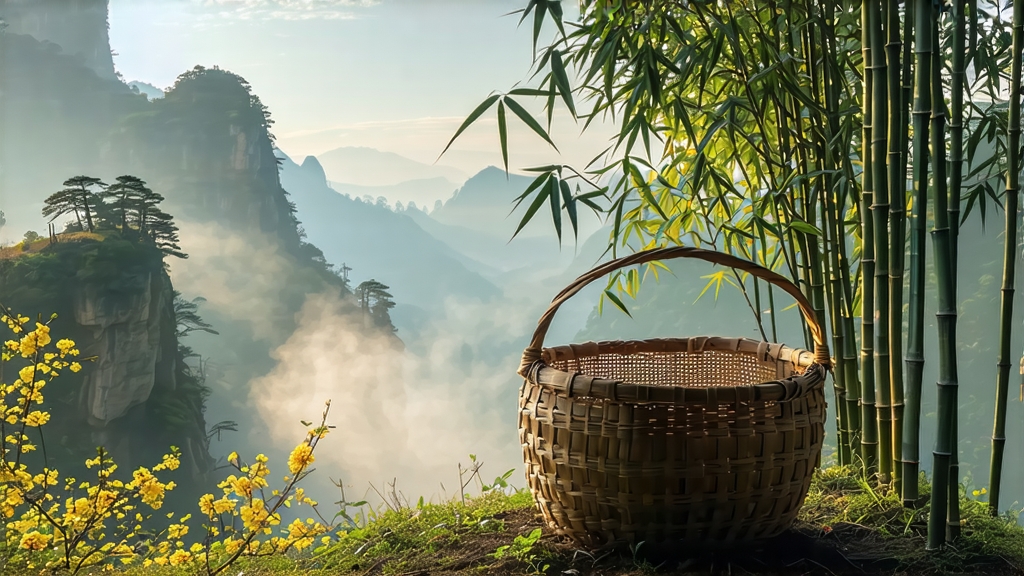
Tucked high above the Sichuan basin, where the Himalayas begin their gentle eastward shrug, lies Meng Ding Mountain, a ridge so often cloaked in cloud that ancient poets called it “the stairway to the sky.” It was here, during the Tang dynasty (618-907 CE), that Buddhist monks first coaxed a shy yellow bud out of the camellia sinensis bush and presented it to the emperor. The court’s scribes recorded the moment in gold ink: “a tea the color of dawn, whose fragrance lingers like a wise whisper.” Thus Meng Ding Huang Ya—literally “Meng Ding Yellow Bud”—was born, and for seven consecutive dynasties it rode the postal roads to Chang’an and later to Beijing as one of China’s earliest authenticated tribute teas. Foreign caravans carried small lacquered caddies westward along the Tea-Horse Road, but the variety never strayed far from its misty cradle; by the twentieth century it had become a reclusive legend, eclipsed by green teas that traveled better and cheaper. Only in the early 1990s did a handful of Sichuan horticulturists revive the cultivar, combing monastery ledgers for withered scrolls that described its arcane “sealed yellowing” process. Today fewer than 3,000 kg of authentic Meng Ding Huang Ya reach the market each spring, making it rarer per gram than silver.
Meng Ding Huang Ya belongs to the micro-category of Chinese yellow tea, a class sometimes mis-labeled “oxidized green” by Western textbooks. In truth it occupies a flavor corridor all its own, suspended between the grassy snap of green tea and the honeyed depth of lightly oxidized oolong. Three sub-varietals survive: the original “Gong Ting” grade, picked when the bud is still closed like a grain of rice; the “Yi Ji” grade, which includes the first unfolded leaf; and the humbler “Er Ji” grade, allowed two leaves and a bud. Purists insist that only the Gong Ting plucked between Qing Ming and Grain Rain (early April) deserves the imperial name, yet all three share the same genetic fingerprint—an ancient clone known locally as “xiao ye zhong,” small-leaf China bush, whose leaves are no longer than the nail of a pinky finger.
Crafting Meng Ding Huang Ya is a meditation on humidity and patience. After the dawn pluck—always before the mountain thermals rise and wrinkle the leaf—workers spread the buds on bamboo trays in a shaded pavilion. A 30-minute high-temperature sha qing (kill-green) follows, hot enough to freeze enzymatic browning yet brief enough to keep the bud’s downy tip intact. What happens next distinguishes yellow from green: the still-warm leaves are wrapped, bundle by bundle, in thin cotton cloth and placed inside a pine-fired warming cabinet maintained at 28–32 °C and 75 % humidity. There they sleep for 60 to 90 minutes, exhaling trapped moisture and re-absorbing it in rhythmic cycles. This “men huang” (sealed yellowing) is repeated three to five times over two nights, coaxing polyphenols into mellow aminoc acids and teasing out a whisper of methyl anthranilate, the compound responsible for the tea’s signature grape-skin top note. Finally the buds are given a gentle charcoal finish over embers of local cedar, lowering residual moisture to 5 % without adding smoke. The result is a leaf the color of antique parchment, curled like a miniature shrimp, releasing a scent that mingles sweet corn, orchid, and a suggestion of wet slate.
To brew Meng Ding Huang Ya respectfully, one must borrow the mountain’s own timetable. Begin with soft water—TDS below 50 ppm—brought to 85 °C, the temperature at which tiny fish-eye bubbles cling to the kettle walls. Use a tall glass or a porcelain gaiwan of 120 ml; weight 3 g of dry buds, about a level teaspoon. Rinse with a splash of 75 °C water and discard immediately; this awakens the leaf without scalding the down. First infusion: 30 seconds, pouring slowly along the vessel’s edge so that the buds tumble like slow-motion fireworks. The liquor emerges the color of chardonnay kissed by sunrise. Second infusion: 20 seconds, revealing a silkier body and a note of steamed edamame. Third infusion: 35 seconds, when the grape-skin aroma re-enters, lingering on the soft palate. Four infusions are customary; a fifth is possible if your water is patient and